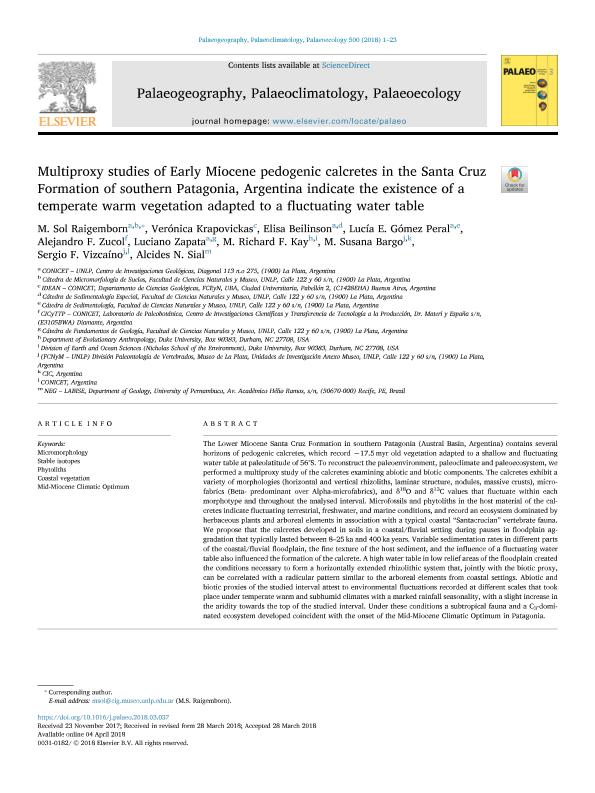Artículo
Multiproxy studies of Early Miocene pedogenic calcretes in the Santa Cruz Formation of southern Patagonia, Argentina indicate the existence of a temperate warm vegetation adapted to a fluctuating water table
Raigemborn, María Sol ; Krapovickas, Verónica
; Krapovickas, Verónica ; Beilinson, Elisa
; Beilinson, Elisa ; Gómez Peral, Lucia
; Gómez Peral, Lucia ; Zucol, Alejandro Fabián
; Zucol, Alejandro Fabián ; Zapata, Luciano
; Zapata, Luciano ; Kay, M. Richard F.; Bargo, María Susana; Vizcaíno, Sergio Fabián
; Kay, M. Richard F.; Bargo, María Susana; Vizcaíno, Sergio Fabián ; Sial, Alcides N.
; Sial, Alcides N.
 ; Krapovickas, Verónica
; Krapovickas, Verónica ; Beilinson, Elisa
; Beilinson, Elisa ; Gómez Peral, Lucia
; Gómez Peral, Lucia ; Zucol, Alejandro Fabián
; Zucol, Alejandro Fabián ; Zapata, Luciano
; Zapata, Luciano ; Kay, M. Richard F.; Bargo, María Susana; Vizcaíno, Sergio Fabián
; Kay, M. Richard F.; Bargo, María Susana; Vizcaíno, Sergio Fabián ; Sial, Alcides N.
; Sial, Alcides N.
Fecha de publicación:
07/2018
Editorial:
Elsevier Science
Revista:
Palaeogeography, Palaeoclimatology, Palaeoecology
ISSN:
0031-0182
Idioma:
Inglés
Tipo de recurso:
Artículo publicado
Clasificación temática:
Resumen
The Lower Miocene Santa Cruz Formation in southern Patagonia (Austral Basin, Argentina) contains several horizons of pedogenic calcretes, which record −17.5 myr old vegetation adapted to a shallow and fluctuating water table at paleolatitude of 56°S. To reconstruct the paleoenvironment, paleoclimate and paleoecosystem, we performed a multiproxy study of the calcretes examining abiotic and biotic components. The calcretes exhibit a variety of morphologies (horizontal and vertical rhizoliths, laminar structure, nodules, massive crusts), microfabrics (Beta- predominant over Alpha-microfabrics), and δ18O and δ13C values that fluctuate within each morphotype and throughout the analysed interval. Microfossils and phytoliths in the host material of the calcretes indicate fluctuating terrestrial, freshwater, and marine conditions, and record an ecosystem dominated by herbaceous plants and arboreal elements in association with a typical coastal “Santacrucian” vertebrate fauna. We propose that the calcretes developed in soils in a coastal/fluvial setting during pauses in floodplain aggradation that typically lasted between 8–25 ka and 400 ka years. Variable sedimentation rates in different parts of the coastal/fluvial floodplain, the fine texture of the host sediment, and the influence of a fluctuating water table also influenced the formation of the calcrete. A high water table in low relief areas of the floodplain created the conditions necessary to form a horizontally extended rhizolithic system that, jointly with the biotic proxy, can be correlated with a radicular pattern similar to the arboreal elements from coastal settings. Abiotic and biotic proxies of the studied interval attest to environmental fluctuations recorded at different scales that took place under temperate warm and subhumid climates with a marked rainfall seasonality, with a slight increase in the aridity towards the top of the studied interval. Under these conditions a subtropical fauna and a C3-dominated ecosystem developed coincident with the onset of the Mid-Miocene Climatic Optimum in Patagonia.
Archivos asociados
Licencia
Identificadores
Colecciones
Articulos(CICYTTP)
Articulos de CENTRO DE INV.CIENT.Y TRANSFERENCIA TEC A LA PROD
Articulos de CENTRO DE INV.CIENT.Y TRANSFERENCIA TEC A LA PROD
Articulos(CIG)
Articulos de CENTRO DE INVEST.GEOLOGICAS (I)
Articulos de CENTRO DE INVEST.GEOLOGICAS (I)
Articulos(IDEAN)
Articulos de INSTITUTO DE ESTUDIOS ANDINOS "DON PABLO GROEBER"
Articulos de INSTITUTO DE ESTUDIOS ANDINOS "DON PABLO GROEBER"
Citación
Raigemborn, María Sol; Krapovickas, Verónica; Beilinson, Elisa; Gómez Peral, Lucia; Zucol, Alejandro Fabián; et al.; Multiproxy studies of Early Miocene pedogenic calcretes in the Santa Cruz Formation of southern Patagonia, Argentina indicate the existence of a temperate warm vegetation adapted to a fluctuating water table; Elsevier Science; Palaeogeography, Palaeoclimatology, Palaeoecology; 500; 7-2018; 1-23
Compartir
Altmétricas



